
© Andy Ross. (Click image for larger version)
Kenneth MacMillan: a National Celebration
Scottish Ballet: Le Baiser de la fée (The Fairy’s Kiss)
Birmingham Royal Ballet: Concerto
The Royal Ballet: Jeux
★★★★✰
London, Royal Opera House
18 October 2017
Gallery of pictures by Dave Morgan
www.roh.org.uk
In the first of the mixed bills celebrating Kenneth MacMillan’s ballets, 25 years after his death, Le Baiser de la fée intrigued me because the questions it posed about his development as a choreographer. Concerto (1966) and Elite Syncopations (1974) are straightforward to enjoy, in fine performances by Birmingham Royal Ballet and the resident company, with guests from four other British companies in Elite.
Scottish Ballet’s production of Le Baiser de la fée goes back to the 1960 original choreography, which MacMillan created after The Burrow and before The Invitation. Both those one-act ballets had scenarios that MacMillan invented. For Baiser, he was obliged to follow Stravinsky’s scenario; his own alternative version (of which more later) was rejected by the composer, still very much alive. So what did MacMillan hear in the music, Stravinsky’s tribute to Tchaikovsky on the 35th anniversary of his death?

© Dave Morgan, courtesy the Royal Opera House. (Click image for larger version)
I suspect he reasoned that the story was not a truly tragic one – at least, not for the principal male character. Based on Hans Christian Andersen’s The Ice Maiden, the scenario tells of a young man about to get married who is claimed by the Ice Fairy. She takes him to the Land Beyond Time and Place, to live there eternally. Stravinsky saw the fairy tale as an allegory of a creator’s life, the Muse having branded Tchaikovsky with her kiss.
The music for the Fairy and her attendants is far from forbidding, and nor is MacMillan’s choreography. She is a seductress who lures the young man away from his future as a family man in order to give him immortality. Though Stravinsky echoes Tchaikovsky’s setting of Goethe’s poem, ‘None but the lonely heart can know my sadness’, the arrangement is entrancing. Maybe swapping domestic life for artistic fame isn’t such a bad bargain after all.
The sufferer is the abandoned bride-to-be. MacMillan originally intended her to die at the end, pierced by an icy shard wielded by one of the Fairy’s attendants. Instead, she searches for him in vain before the curtain falls. (Perhaps she eventually dies from exposure, or returns to marry a sensible villager, like Effie in La Sylphide.) In reviews of the 1960 production, Lynn Seymour elicited great sympathy for the bride’s plight: Bethany Kingsley-Garner rather less so in Scottish Ballet’s account because her face couldn’t be seen clearly enough.
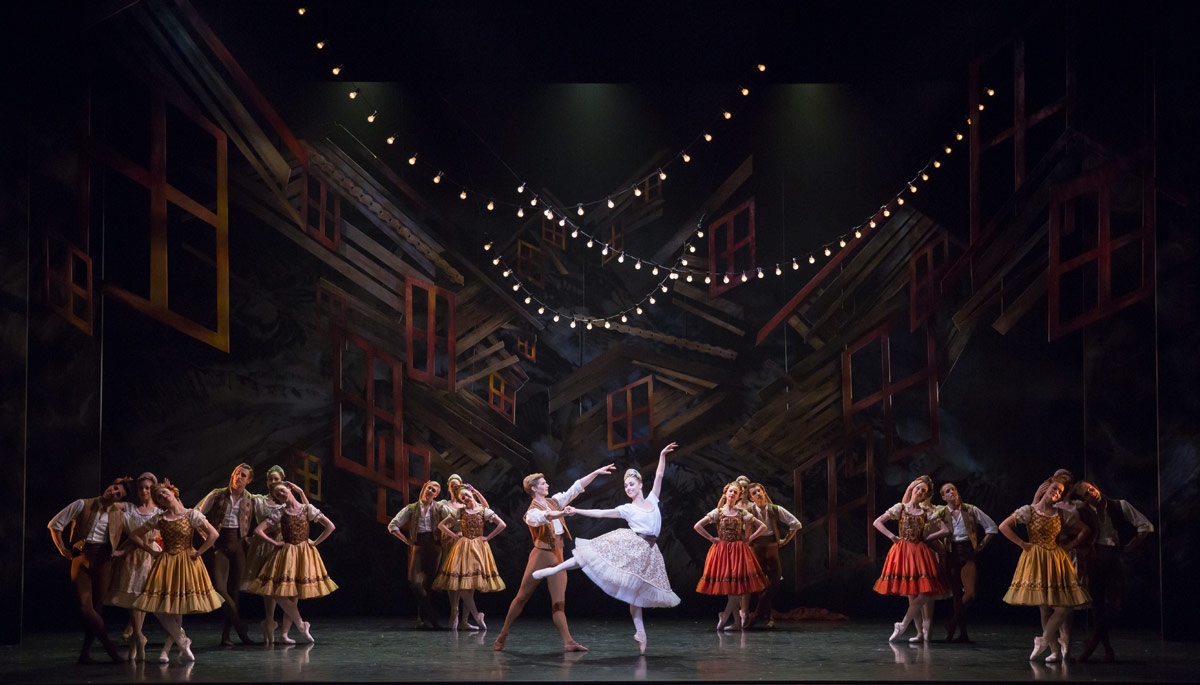
© Andy Ross. (Click image for larger version)
Gary Harris’s setting for the Fairy’s inhuman domain is impressively cold and craggy. When we first see it behind a scrim, a woman holding a baby is caught in a storm in the mountains. Yet the music, a lullaby, isn’t threatening and nor is the arrival of the Ice Fairy and her attendants. They dance swiftly and sharply to Stravinsky’s quixotic rhythms, the Fairy (Constance Devernay) at their centre. They’re not demonic – just so ‘other’ in their frosted costumes that they are unseen by the peasants who rescue the baby.
Village festivities some 20 years later recall those in Coppélia. To boisterous folk music, young men leap and bound, while girls look on admiringly. A band of musicians passes through, hopping on alternate beats as they play primitive instruments. (MacMillan excised the band from his 1986 revival of the ballet.) The setting is bright and cheerful, though mountains loom behind colourful suspended village houses.
The bride-to-be is sweetly naïve, dancing adoringly with her fiançé (Andrew Peasgood). We have to intuit that he was the baby kissed by the Fairy, and that the Gypsy who insinuates herself into the festivities (Mia Thompson) will turn out to be the Fairy. Unwisely, the bride leaves her fiançé alone with the shrouded gypsy. Devernay substitutes herself, offering the young man what his girlfriend doesn’t yet dare – consummation, sexual and mystical.
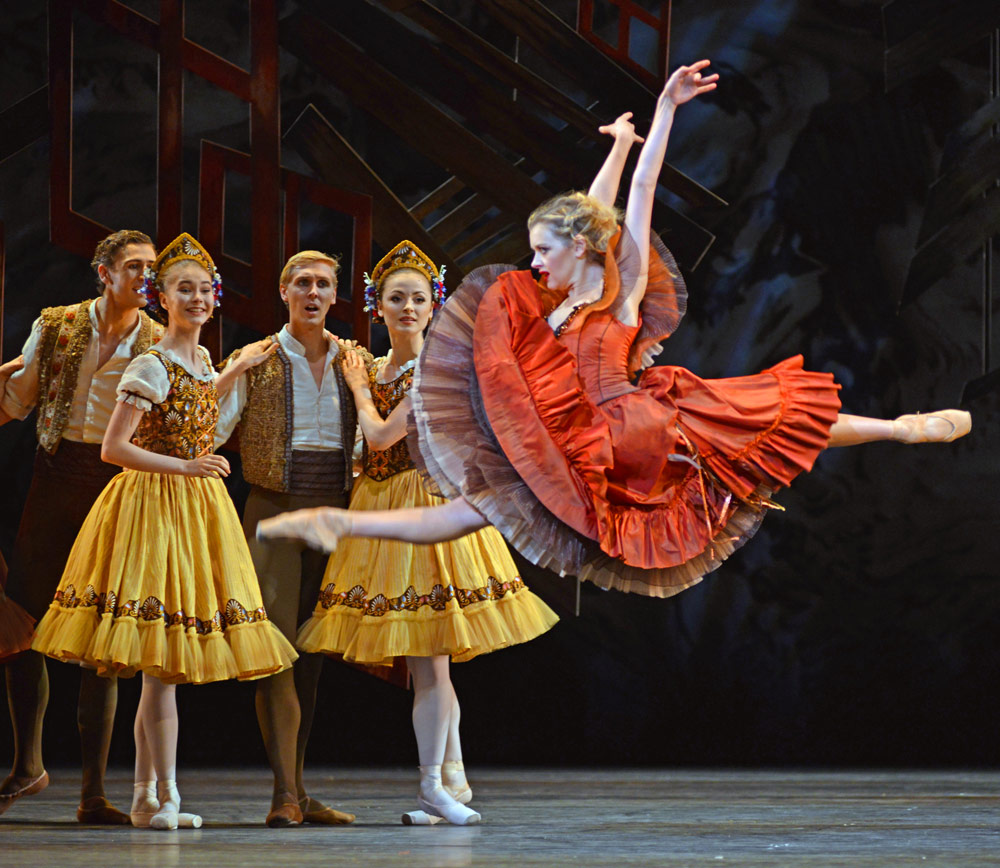
© Dave Morgan, courtesy the Royal Opera House. (Click image for larger version)
This is what makes MacMillan’s concept of the Fairy’s kiss so intriguing. Her several pas deux with the young man are sensual, daringly unconventional. She winds her body around him, arches over his shoulders in cartwheels that bring her head close to his. He kneels on his haunches, supporting her waist as she lunges down to him – an intimate lift that he would use again, notably in Romeo and Juliet. After her first encounter with the boy, the Fairy puts her hands over his eyes, so that he won’t remember her just yet.
The scene reverts to the village, where the bride and her six friends are preparing for the wedding. The choreography is MacMillan’s deliberate homage to Ashton, who was preparing La Fille mal gardée at the same time. (Its premiere and Baiser’s were less than two months apart.) The girlfriends’ steps are speedy, with swift changes of direction, yielding upper bodies and heads thrown back in delight. The bride’s solo has ecstatic leaps and lunges, arms surrendering in anticipation of married bliss. The young man enters to show off his prowess in a virtuoso solo, as well as partnering the bridesmaids, two at a time.

© Andy Ross. (Click image for larger version)
When he dances with his fiançée, however, he’s bewildered by a double image of her. The Fairy has joined in, performing the same steps and sharing the lifts. She is invisible to anyone else, so the bridal party, unconcerned, departs for the church. This time, the Fairy claims her prize possessively, enveloping him until he lies supine, her body on top of his.
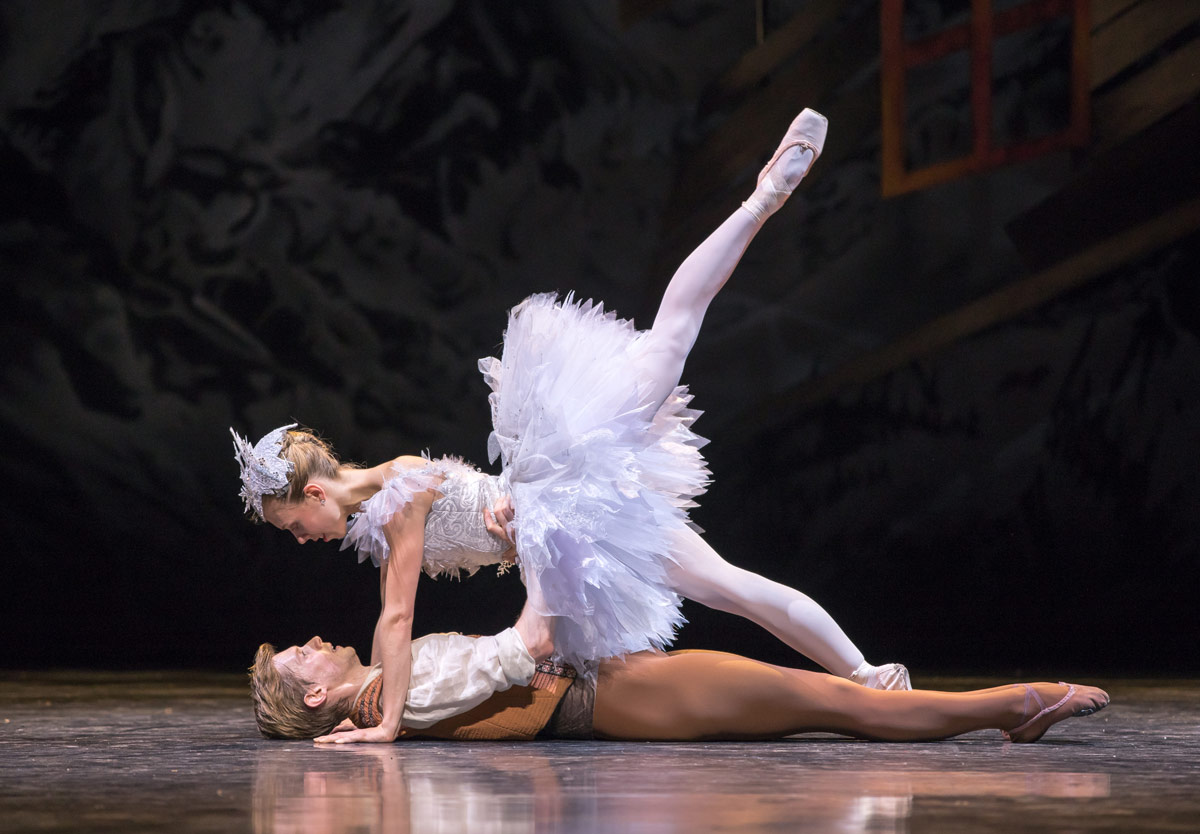
© Andy Ross. (Click image for larger version)
During the long apotheosis, the bride crosses the front of the stage, clutching her bouquet as she looks for her lover. The Fairy’s attendants are revealed in their icy realm. They camouflage the boy entwined with the Fairy so that the lost bride can’t see him. As the music becomes more ethereal, the Fairy’s entourage continues to dance triumphantly in couples, as in a classical ballet finale. The Land Beyond Time and Place can’t be lonely, unless the captivated man resents his transfiguration. In a final image, he’s held in the Fairy’s arms as the curtains close.
There’s no way of knowing that he might be an artist, paying a price for his gifts. The ending doesn’t work as an allegory – a problem faced by all choreographers (and there are many) of Le Baiser de la fée. Stravinsky is to blame for the inconsistencies in the plot and the length of some of the scenes. MacMillan, however, understands how to respond to music that isn’t an easy fit with the actions it purports to describe: Stravinsky wasn’t as obliging as Tchaikovsky. The range of choreographic invention is a revelation, from the formal patterns of the Fairy’s entourage to the bouncy folk dances of the villagers, the crochet-work steps of the bridesmaids to the erotically charged lifts for the Fairy. MacMillan was displaying his portfolio of talents as a classical ballet narrative dance-maker.
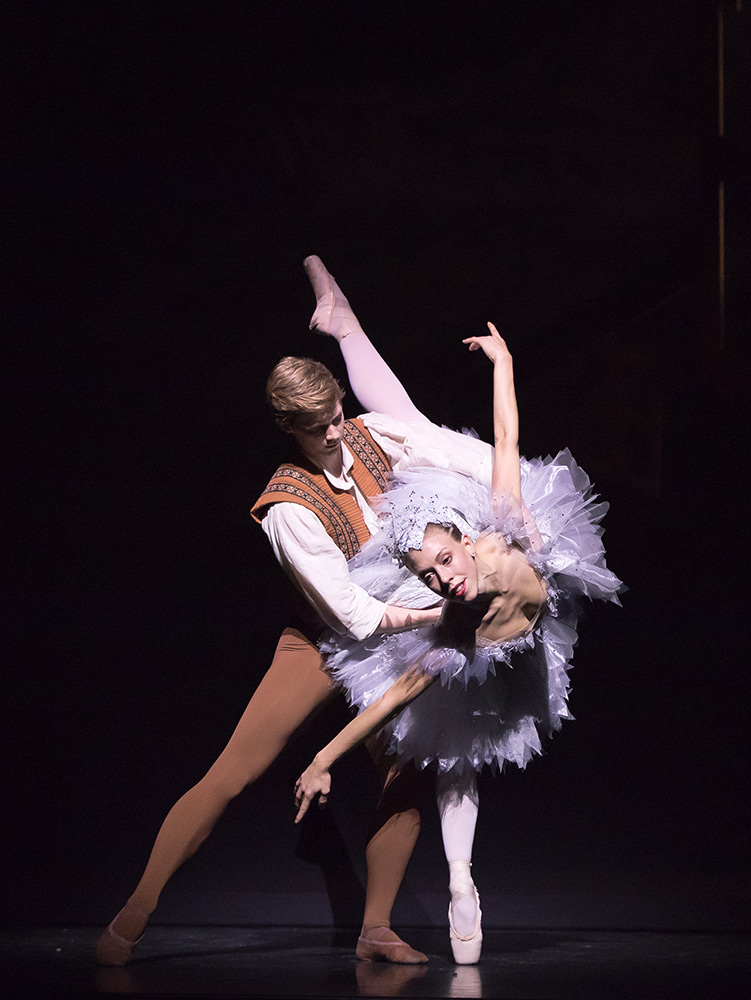
© Andy Ross. (Click image for larger version)
Scottish Ballet serves him well in an attractive production that does away with awkward scene changes. There’s an imbalance, though, in the way the bride and the Fairy are portrayed. Glimpses of Lynn Seymour in a 1962 film, re-mastered by Lynn Wake for her documentary, New Wave Ballet (screened at an Insight evening on 20 October) show how delectable Seymour was as the fiançée, how desperate at the loss of her lover. Kingsley-Garner, though charming, was much on a level as a village maiden. Devernay had the advantage of choreography that MacMillan would develop for his amoral heroines, Manon and Mary Vetsera. As a result, Devernay’s Fairy won the bemused young man too easily away from his bride with erotic promise.
Placed between sunny Concerto and showy Elite Syncopations, Le Baiser de la fée was a bit of a downer for those baffled by the plot. It’s a valuable return to the MacMillan canon, however, and a fine addition to Scottish Ballet’s repertoire. Concerto has long been in Birmingham Royal Ballet’s rep, ever since its earlier days as Sadler’s Wells touring company in 1967. The present company dance it well, with special credit going to the central pas de deux couple, Jenna Roberts and Tyrone Singleton. (Since Elite Syncopations will be performed again in another programme, I’ll review it then.)

© Andy Ross. (Click image for larger version)
As a taster before some of the main stage MacMillan bills, Royal Ballet dancers are performing Jeux, Wayne Eagling’s tribute to MacMillan by way of Vaslav Nijinky, its original choreographer in 1913. MacMillan had reconstructed elements of Jeux for Herbert Ross’s film Nijinsky in 1980, drawing on photographs, sketches and descriptions. Eagling drew in turn on MacMillan’s choreography, incorporating it into a 20 minute ballet to Debussy’s commissioned score. First performed by English National Ballet, Eagling’s Jeux features a vulnerable choreographer working out his ideas in a context of controversy – much like MacMillan himself.
This version, performed in the Clore Studio Upstairs, has no resemblance to the Nijinsky ballet reconstructed by Millicent Hodson and Kenneth Archer, performed by the Royal Ballet in 2000. That production had a set, based on the original by Leon Bakst. In the Clore, there are just a few props: a chair, two portable ballet barres and a bouncing ball.
Nijinsky (Vadim Muntagirov) contemplates his sketchbook as two dancers warm up at the barres. He tries out angular moves he will use in L’après-midi d’un faune and Rite of Spring. Following a tennis ball, three young people enter in balletic sporting clothes. We see poses familiar from photographs of the 1913 Jeux, and references to the two grey girls in Nijinska’s Les Biches. There are suggestions of a shocking ménage à trois, though the two women might be more interested in each other. All six dancers join in dances with gestures from different ball games, before leaving the scene. Alone again, Nijinsky is approached by Diaghilev. As Debussy’s lush music turns very sinister, Nijinsky puts his head in his hands. Diaghilev is his bad Fairy, offering him immortality at the price of his sanity. How fitting that Eagling’s jeux d’esprit appeared on the same evenings as Le Baiser de la fée.















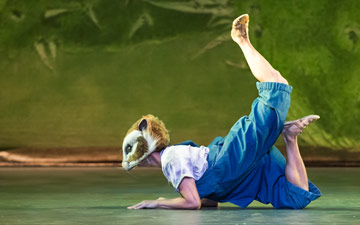

You must be logged in to post a comment.